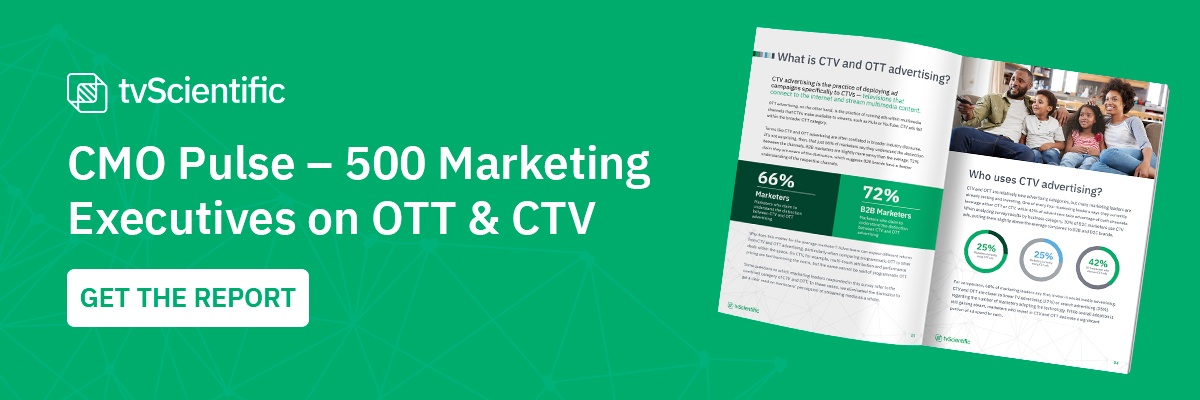OTT advertising is gaining some serious market momentum. What’s on your watchlist?
Today, 57% of consumers get their television content through digital streaming, while only 26% use cable or linear TV. Connected TV (CTV) and over-the-top (OTT) platforms like Netflix have become the new normal. This groundbreaking shift sets the stage for TV to become a true performance marketing channel. Meanwhile investors are turning heads at the latest CTV statistics — adoption and ad spend are surging.
So, should OTT and CTV ads be a part of your digital marketing plan? If you’re looking for a transparent, cost-effective, and reliably attributable way to engage consumers, the answer is probably yes. For marketers, these OTT statistics provide the context and proofpoints you need to effectively allocate your budget. Investors should also stay tuned to hear why this corner of adtech is booming.
Our comprehensive guide, What Is OTT Advertising? Why Over-The-Top Is the Channel to Watch, can help take your strategy to the next level.
OTT Statistics to Add to Your Watch List
OTT has seen steady growth in recent years. One simple reason is that consumers are tired of paying exorbitantly high amounts of money for cable. Data shows that the average cable package is priced at $217.42 per month. Subscribing to several OTT services is significantly cheaper.
The increase in overall OTT programming quality is another key factor that keeps viewers coming back for more. Netflix, Hulu, HBOMax, Amazon Prime, and other streaming services create compelling and original programming — often exceeding what we saw in the heyday of cable television thanks to their large budgets. Smart TV manufacturer Vizio found that just one-third of television consumption is linear, which is a massive shift from the 60% it was at two years ago. This can largely be attributed to the addition of new streaming providers that are churning out top-notch, award-winning content.
Additionally, OTTs completely redefined the way in which programming was released. Instead of waiting a week to watch the next episode of a show, many streaming services today release an entire season at once, which creates massive increases in consumption.
However, simply knowing that more consumers are turning to streaming services for their video content isn’t enough to formulate an effective marketing strategy. Achieving the highest possible performance requires a more granular understanding of what viewers are doing, when, and why.
Here are the key OTT and CTV statistics to keep in mind.
1. Daily Consumption
It all starts with the amount of time actually spent in front of the television watching video content. In 2018, the average American spent 44 minutes a day consuming OTT video. That number jumped to 62 minutes per day in 2020 when the pandemic hit, and it is projected to reach 70 minutes a day by 2022.
The improvement in technology in tandem with the pandemic certainly accelerated the way in which people consume media, but they also led to an increase in their treatment of CTV as a more interactive experience in which viewers have become more willing to make digital purchases. This means a greater potential return for digital marketers buying advertising space and the opportunity to jump on things such as shoppable content.
2. Number of Users
Another key OTT viewership statistic to be aware of is the number of users streaming this type of content.
It is estimated that OTT subscriptions in the United States will jump from 230 million in 2021 to over 277 million in 2026 — an increase of 20% over those five years. It’s also worth knowing that OTT’s top adopters tend to be Millennials and Gen Z: 80% of those generations consume video on at least one platform monthly.
As OTT content continues to improve, it will open up channels for more viewers to become involved. Though the primary consumers of this type of content are currently young adults, CTV will continue to scale and tap into the younger markets as well as the older markets to create content and advertising that aligns with the specific wants and needs of these demographics.
3. Overall Revenue
Unsurprisingly, growth in OTT viewership statistics correlates to growth in OTT revenue. Research shows that OTT media revenue in the United States hit $106 billion in 2020, and is expected to double to $210 billion by 2026. This translates to the projection that revenue for OTT video will show an annual growth rate of 9.72% from now until 2026.
The largest segment of this revenue is OTT video advertising, which is slated to reach $87,261 million this year in the United States. This accounts for over 51% of the total revenue in the OTT market.
4. OTT Advertising Spend
In 2021, OTT advertising spend on connected TV reached $14.44 billion, a 59.9% increase over 2020’s spending. That number is projected to reach $27.47 billion by 2025.
The major shift from a focus on linear TV marketing spend to a focus on OTT/CTV advertising is largely due to the fact that OTT/CTV allows for better targeting and attribution. This form of advertising provides the opportunity for more personalized messaging across multiple platforms that has more precise targeting, which lowers the likelihood of wasted marketing dollars.
How to Use OTT Statistics to Your Benefit
OTT statistics are growing in nearly every category. In particular, CTV looks increasingly promising for marketers looking to marry the value of OTT with the performance of digital channels. Here are some reasons to consider testing CTV and OTT ads.
It minimizes ad spend waste
OTT advertising is one of the most targeted forms of digital marketing that exists. Rather than paying for ads on TV that are broad and generalized, you can target your ads to be viewed exclusively by those who have proven interest in your product or service (based on other viewing and shopping habits). This helps increase awareness of your brand and does so in a way to convert the viewers into customers.
Additionally, OTT advertising allows you to target a consumer wherever they may be, whatever they’re watching, regardless of what platform they’re viewing content on. This allows digital marketers and investors to target people based on their individual viewing habits and create targeted ads that have a higher chance of success.
Unlike OTT advertising, CTV advertising often allows you to pay on a CPA or CPI basis, rather than per impression, stretching your ad budget even further.
It allows you to reach audiences across multiple platforms
With OTT advertising, you can retarget audiences on social media, websites, and more. This brings viewers into multiple different channels of your marketing strategy, which will increase engagement and increase your conversion.
CTV retargeting also allows you to shore up the consumer journey from web to TV. The use of a simple pixel makes it possible to retarget in front of the big screen.
It allows for easy measurement
As a digital marketer, being able to track the performance of your campaigns is key. OTT ads make it easy to do this due to their use of in-depth analytics that show OTT statistics such as views and completion rates. Brands no longer have to wonder whether viewers actually saw their ads (which is the case with traditional television). Things such as pixel-based tracking allows brands and businesses to determine whether a person viewed an ad, and whether that viewing prompted action. This means you can calculate your ROI with greater ease and see what’s working best.
Because smart TVs are tied to a consistent IP address, they also make multi-touch attribution possible across various household devices. (Learn more about CTV measurement here!)
One of the struggles with OTT and CTV advertising is maximizing your budget through a transparent partner. And that’s where a buying and attribution platform such as tvScientific comes in. tvScientific is the first CTV advertising platform that combines the power of television and the precision and measurability of digital marketing into one. To learn more about how tvScientific can help with your business or brand’s marketing strategy today, get in touch.








